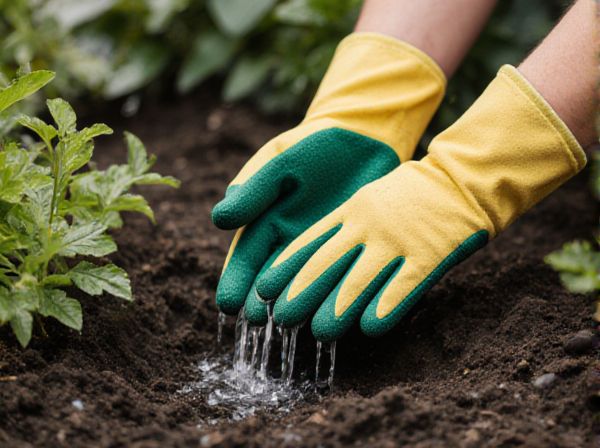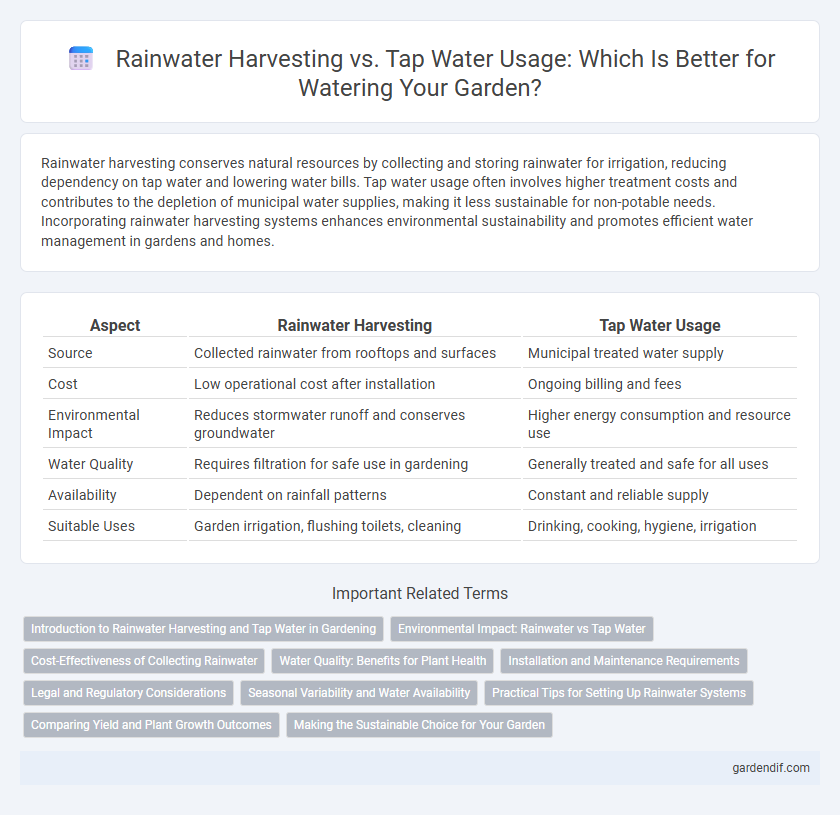
Rainwater harvesting vs Tap water usage Illustration
Rainwater harvesting conserves natural resources by collecting and storing rainwater for irrigation, reducing dependency on tap water and lowering water bills. Tap water usage often involves higher treatment costs and contributes to the depletion of municipal water supplies, making it less sustainable for non-potable needs. Incorporating rainwater harvesting systems enhances environmental sustainability and promotes efficient water management in gardens and homes.
Table of Comparison
| Aspect | Rainwater Harvesting | Tap Water Usage |
|---|---|---|
| Source | Collected rainwater from rooftops and surfaces | Municipal treated water supply |
| Cost | Low operational cost after installation | Ongoing billing and fees |
| Environmental Impact | Reduces stormwater runoff and conserves groundwater | Higher energy consumption and resource use |
| Water Quality | Requires filtration for safe use in gardening | Generally treated and safe for all uses |
| Availability | Dependent on rainfall patterns | Constant and reliable supply |
| Suitable Uses | Garden irrigation, flushing toilets, cleaning | Drinking, cooking, hygiene, irrigation |
Introduction to Rainwater Harvesting and Tap Water in Gardening
Rainwater harvesting collects and stores rainwater for garden irrigation, reducing dependency on municipal tap water and lowering water bills. This sustainable practice preserves groundwater resources while providing plants with natural, chemical-free hydration. In contrast, tap water usage ensures a reliable water supply but often contains chlorine and other additives that may impact soil health over time.
Environmental Impact: Rainwater vs Tap Water
Rainwater harvesting significantly reduces reliance on municipal tap water, conserving valuable freshwater resources and lowering energy consumption associated with water treatment and distribution. Tap water usage often involves higher carbon emissions due to pumping, treating, and transporting water over long distances. Utilizing rainwater for irrigation decreases runoff and erosion while minimizing chemical exposure to ecosystems compared to conventional tap water usage.
Cost-Effectiveness of Collecting Rainwater
Collecting rainwater for watering purposes significantly reduces dependency on tap water, leading to lower utility bills and long-term financial savings. Initial installation costs of rainwater harvesting systems are quickly offset by the decreased expenditure on municipal water, especially in regions with high water tariffs. Efficient rainwater collection minimizes water wastage and offers a sustainable, cost-effective solution for irrigation and garden maintenance.
Water Quality: Benefits for Plant Health
Rainwater harvesting provides naturally soft water free from chlorine and other chemicals commonly found in tap water, promoting healthier plant growth by preserving soil microbiota and nutrient absorption. Tap water often contains additives like fluoride and salts that can accumulate, potentially harming sensitive plants and altering soil pH balance. Using rainwater enhances plant vitality by delivering cleaner, more balanced moisture essential for robust root development and overall plant health.
Installation and Maintenance Requirements
Rainwater harvesting systems require the installation of gutters, storage tanks, and filtration units, often necessitating periodic cleaning to prevent blockages and contamination. Tap water systems involve straightforward piping and valves with minimal maintenance, typically limited to occasional leak repairs and pressure checks. The initial setup cost and complexity for rainwater harvesting are higher, but it reduces dependency on municipal water supply and can lower long-term water expenses.
Legal and Regulatory Considerations
Rainwater harvesting regulations vary significantly based on regional water rights and environmental policies, often requiring permits to ensure sustainable usage and prevent conflicts with municipal water supplies. Tap water usage is typically governed by stringent safety standards and local government regulations to guarantee public health and resource allocation. Compliance with legal frameworks for both water sources is essential to optimize water management and avoid penalties.
Seasonal Variability and Water Availability
Rainwater harvesting effectively addresses seasonal variability by capturing and storing precipitation during wet periods, ensuring a reliable water supply during dry seasons. Tap water usage relies on municipal sources that may fluctuate in availability due to demand and infrastructure constraints. Integrating rainwater harvesting reduces dependency on tap water, enhancing overall water availability for irrigation and household needs amid changing climate patterns.
Practical Tips for Setting Up Rainwater Systems
Setting up an efficient rainwater harvesting system involves installing a clean, durable collection surface such as a sloped roof, paired with guttering to direct runoff into storage tanks equipped with first-flush diverters to prevent debris contamination. Using filtered, covered tanks helps maintain water quality, ensuring suitability for garden irrigation and reducing dependence on tap water, which consumes municipal resources and increases utility costs. Incorporating a simple pump or gravity-fed distribution system optimizes water flow for practical usage during dry periods, enhancing sustainability and water conservation efforts.
Comparing Yield and Plant Growth Outcomes
Rainwater harvesting typically yields higher-quality water with fewer chemicals, enhancing soil absorption and promoting healthier plant growth compared to tap water. Studies indicate that plants watered with rainwater demonstrate increased biomass and more robust root systems due to its natural nutrient content and balanced pH. Conversely, tap water, often treated with chlorine and fluoride, can sometimes hinder microbial activity in the soil, potentially limiting optimal plant development.
Making the Sustainable Choice for Your Garden
Rainwater harvesting conserves potable water by collecting and storing roof runoff, reducing dependence on municipal tap water and lowering water bills. Gardens irrigated with rainwater benefit from natural nutrients, enhancing soil health and promoting sustainable plant growth without chemical additives found in tap water. Choosing rainwater harvesting supports environmental sustainability by conserving groundwater resources and minimizing the carbon footprint associated with water treatment and distribution.
Rainwater harvesting vs Tap water usage Infographic

 gardendif.com
gardendif.com